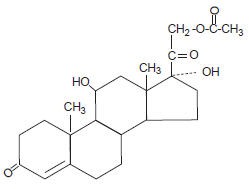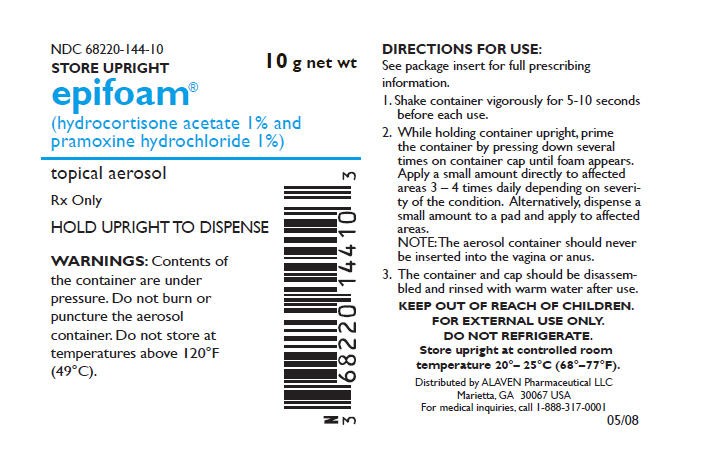Epifoam
epifoam (hydrocortisone acetate 1% and pramoxine hydrochloride 1%)
FULL PRESCRIBING INFORMATION: CONTENTS*
- EPIFOAM DESCRIPTION
- CLINICAL PHARMACOLOGY
- EPIFOAM INDICATIONS AND USAGE
- EPIFOAM CONTRAINDICATIONS
- WARNINGS
- PRECAUTIONS
- EPIFOAM ADVERSE REACTIONS
- OVERDOSAGE
- EPIFOAM DOSAGE AND ADMINISTRATION
- HOW SUPPLIED
- PRINCIPAL DISPLAY PANEL - 10 g Label
FULL PRESCRIBING INFORMATION
topical aerosol
Rx Only
EPIFOAM DESCRIPTION
Epifoam® (hydrocortisone acetate 1% and pramoxine hydrochloride 1%) is a topical aerosol foam containing: hydrocortisone acetate 1% and pramoxine hydrochloride 1% in a base containing: propylene glycol, cetyl alcohol, glyceryl monostearate and PEG 100 stearate blend, laureth-23, polyoxyl-40 stearate, methylparaben, propylparaben, trolamine, purified water and inert propellants: isobutane and propane.
Epifoam® contains a synthetic corticosteroid used as an anti-inflammatory/antipruritic agent and a local anesthetic.
Hydrocortisone acetate
Molecular weight: 404.50. Solubility of hydrocortisone acetate in water: 1mg/100mL.
Chemical name: Pregn-4-ene-3, 20-dione, 21-(acetyloxy)-11, 17-dihydroxy-(11β)-.

Pramoxine hydrochloride
Molecular weight: 329.86. Pramoxine hydrochloride is freely soluble in water.
Chemical name: morpholine, 4-[3-(4-butoxyphenoxy) propyl]-, hydrochloride.

CLINICAL PHARMACOLOGY
Topical corticosteroids share anti-inflammatory, antipruritic and vasoconstrictive actions. The mechanism of anti-inflammatory activity of the topical corticosteroids is unclear. Various laboratory methods, including vasoconstrictor assays, are used to compare and predict potencies and/or clinical efficacies of the topical corticosteroids. There is some evidence to suggest that a recognizable correlation exists between vasoconstrictor potency and therapeutic efficacy in man.
Pramoxine Hydrochloride
A surface or local anesthetic which is not chemically related to the "caine" types of local anesthetics. Its unique chemical structure is likely to minimize the danger of cross-sensitivity reactions in patients allergic to other local anesthetics.
Pharmacokinetics
The extent of percutaneous absorption of topical corticosteroids is determined by many factors including the vehicle, the integrity of the epidermal barrier, and the use of occlusive dressings.
Topical corticosteroids can be absorbed from normal intact skin. Inflammation and/or disease processes in the skin increase the percutaneous absorption of topical corticosteroids. Occlusive dressings substantially increase the percutaneous absorption of topical corticosteroids. Thus, occlusive dressings may be a valuable therapeutic adjunct for treatment of resistant dermatoses. (See DOSAGE AND ADMINISTRATION.)
Once absorbed through the skin, topical corticosteroids are handled through pharmacokinetic pathways similar to systemically administered corticosteroids. Corticosteroids are bound to plasma proteins in varying degrees. Corticosteroids are metabolized primarily in the liver and are then excreted by the kidneys. Some of the topical corticosteroids and their metabolites are also excreted into the bile.
EPIFOAM INDICATIONS AND USAGE
Topical corticosteroids are indicated for the relief of the inflammatory and pruritic manifestations of corticosteroid-responsive dermatoses.
EPIFOAM CONTRAINDICATIONS
Topical corticosteroid products are contraindicated in those patients with a history of hypersensitivity to any of the components of the preparation.
WARNINGS
Not for prolonged use. If redness, pain, irritation or swelling persists, discontinue use and consult a physician. Contents of the container are under pressure. Do not burn or puncture the aerosol container. Do not store at temperatures above 120°F (49°C). Keep this and all medicines out of the reach of children.
PRECAUTIONS
General
Systemic absorption of topical corticosteroids has produced reversible hypothalamic-pituitary-adrenal (HPA) axis suppression, manifestations of Cushing's syndrome, hyperglycemia and glucosuria in some patients.
Conditions which augment systemic absorption include the application of the more potent steroids, use over large surface areas, prolonged use and the addition of occlusive dressings.
Therefore, patients receiving a large dose of a potent topical steroid applied to a large surface area or under an occlusive dressing should be evaluated periodically for evidence of HPA axis suppression by using the urinary free cortisol and ACTH stimulation tests. If HPA axis suppression is noted, an attempt should be made to withdraw the drug, to reduce the frequency of application, or to substitute a less potent steroid.
Recovery of HPA axis function is generally prompt and complete upon discontinuation of the drug. Infrequently, signs and symptoms of steroid withdrawal may occur, requiring supplemental systemic corticosteroids.
In pediatric patients absorption may result in higher blood levels and thus more susceptibility to systemic toxicity. (See PRECAUTIONS-Pediatric Use.) If irritation develops, topical corticosteroids should be discontinued and appropriate therapy instituted.
In the presence of dermatological infections, the use of an appropriate antifungal or antibacterial agent should be instituted. If a favorable response does not occur promptly, the corticosteroid should be discontinued until the infection has been adequately controlled.
Information for the Patient
Patients using topical corticosteroids should receive the following information and instructions:
- This medication is to be used as directed by the physician. It is for external use only. Avoid contact with the eyes.
- Do not use this medication for any disorder other than for which it has been prescribed.
- The treated skin area should not be bandaged or otherwise covered or wrapped as to be occlusive unless directed by the physician.
- Report any signs of local adverse reactions especially under occlusive dressings.
- Do not use any tight fitting diapers or plastic pants on a pediatric patient being treated in the diaper area, as these garments may constitute occlusive dressings.
Laboratory Tests
The following tests may be helpful in evaluating the HPA axis suppression:
-
-
Carcinogenesis, Mutagenesis, and Impairment of Fertility
Long-term animal studies have not been performed to evaluate carcinogenic potential or the effect on fertility of topical corticosteroids.
Studies to determine mutagenicity with prednisolone and hydrocortisone have revealed negative results.
Pregnancy Category C
Corticosteroids are generally teratogenic in laboratory animals when administered systemically at relatively low dosage levels. The more potent corticosteroids have been shown to be teratogenic after dermal application in laboratory animals. There are no adequate and well-controlled studies in pregnant women of teratogenic effects from topically applied corticosteroids. Therefore, topical corticosteroids should be used during pregnancy only if the potential benefit justifies the potential risk to the fetus. Drugs of this class should not be used extensively on pregnant patients, in large amounts, or for prolonged periods of time.
Nursing mothers
It is not known whether topical administration of corticosteroids could result in sufficient systemic absorption to produce detectable quantities in breast milk. Systemically administered corticosteroids are secreted into breast milk in quantities not likely to have a deleterious effect on the infant. Caution should be exercised when any topical corticosteroids are administered to a nursing woman.
Pediatric Use
PEDIATRIC PATIENTS MAY DEMONSTRATE GREATER SUSCEPTIBILTY TO TOPICAL CORTICOSTEROID-INDUCED HPA AXIS SUPPRESSION AND CUSHING'S SYNDROME THAN MATURE PATIENTS BECAUSE OF A LARGER SKIN SURFACE AREA TO BODY WEIGHT RATIO.
Hypothalamic-pituitary-adrenal (HPA) axis suppression, Cushing's syndrome and intracranial hypertension have been reported in pediatric patients receiving topical corticosteroids. Manifestations of adrenal suppression in pediatric patients include linear growth retardation, delayed weight gain, low plasma cortisone levels and absence of response to ACTH stimulation. Manifestations of intracranial hypertension include bulging fontanelles, headaches, and bilateral papilledema.
Administration of topical corticosteroids to pediatric patients should be limited to the least amount compatible with an effective therapeutic regimen. Chronic corticosteroid therapy may interfere with the growth and development of pediatric patients.
Geriatric Use
Reported clinical experience has not identified differences in responses between the elderly and younger patients. In general, dose selection for an elderly patient should be cautious using the least amount compatible with an effective therapeutic regimen and reflecting the greater frequency of decreased hepatic, renal or cardiac function, and of concomitant disease or other drug therapy.
EPIFOAM ADVERSE REACTIONS
The following local adverse reactions are reported infrequently with topical corticosteroids, but may occur more frequently with the use of occlusive dressings. These reactions are listed in an approximately decreasing order of occurrence:
Burning, Itching, Irritation, Dryness, Folliculitis, Hypertrichosis, Acneiform eruptions, Hypopigmentation, Perioral dermatitis, Allergic contact dermatitis, Maceration of the skin, Secondary infection, Skin atrophy, Striae, Miliaria
OVERDOSAGE
Topically applied corticosteroids can be absorbed in sufficient amounts to produce systemic effects. (See PRECAUTIONS.)
EPIFOAM DOSAGE AND ADMINISTRATION
Apply to affected area 3 to 4 times daily.
Occlusive dressings may be used for the management of psoriasis or recalcitrant conditions. If an infection develops, the use of occlusive dressings should be discontinued and appropriate antimicrobial therapy instituted.
Directions For Use
- Shake the container vigorously for 5-10 seconds before each use.
- While holding container upright, prime the container by pressing down several times on container cap until foam appears. Apply a small amount directly to affected area 3-4 times daily depending on severity of the condition. Alternatively, dispense a small amount to a pad and apply to affected areas.
NOTE: The aerosol container should never be inserted into vagina or anus. - The container and cap should be disassembled and rinsed with warm water after use.
HOW SUPPLIED
Epifoam® is supplied in 10 g pressurized cans.
-
Store upright at controlled room temperature 20° – 25°C (68° – 77°F). DO NOT REFRIGERATE.
Marketed and Distributed by:
ALAVEN
®
PHARMACEUTICAL LLC
Marietta, GA 30067
For Medical Inquiries,
call toll-free 1-888-317-0001
www.alavenpharm.com
4009474
Rev. 08/08
PRINCIPAL DISPLAY PANEL - 10 g Label
NDC 68220-144-10
STORE UPRIGHT
10 g net wt
epifoam®
(hydrocortisone acetate 1% and
pramoxine hydrochloride 1%)
topical aerosol
Rx Only
HOLD UPRIGHT TO DISPENSE
WARNINGS: Contents of
the container are under
pressure. Do not burn or
puncture the aerosol
container. Do not store at
temperatures above 120°F
(49°C).

Epifoamhydrocortisone acetate and pramoxine hydrochloride AEROSOL, FOAM
| ||||||||||||||||||||||||||||||||||||||||||||||||||||||||||||||||||||||||||||||||||||